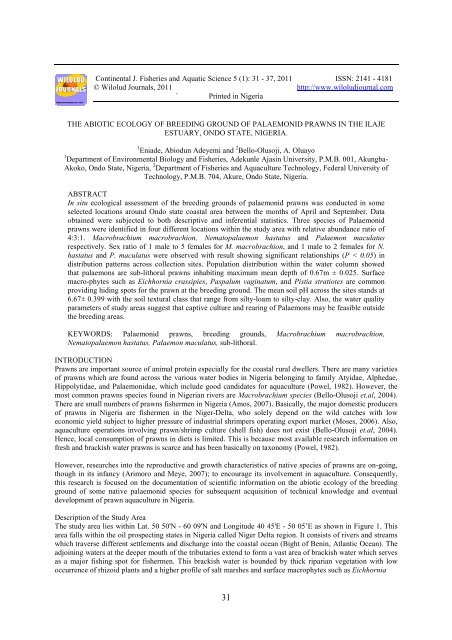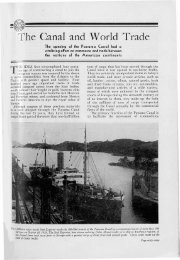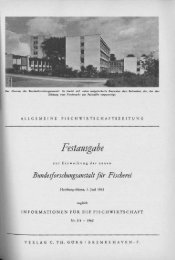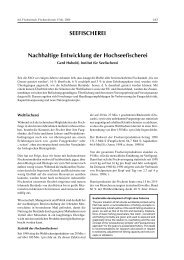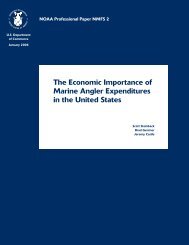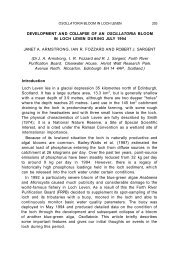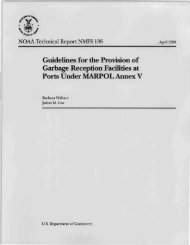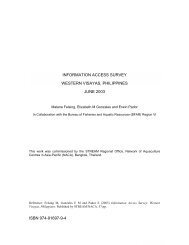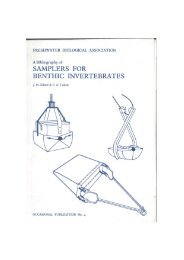Download (185Kb) - Aquatic Commons
Download (185Kb) - Aquatic Commons
Download (185Kb) - Aquatic Commons
You also want an ePaper? Increase the reach of your titles
YUMPU automatically turns print PDFs into web optimized ePapers that Google loves.
Continental J. Fisheries and <strong>Aquatic</strong> Science 5 (1): 31 - 37, 2011 ISSN: 2141 - 4181<br />
© Wilolud Journals, 2011 http://www.wiloludjournal.com<br />
` Printed in Nigeria<br />
THE ABIOTIC ECOLOGY OF BREEDING GROUND OF PALAEMONID PRAWNS IN THE ILAJE<br />
ESTUARY, ONDO STATE, NIGERIA.<br />
1 Eniade, Abiodun Adeyemi and 2 Bello-Olusoji, A. Oluayo<br />
1 Department of Environmental Biology and Fisheries, Adekunle Ajasin University, P.M.B. 001, Akungba-<br />
Akoko, Ondo State, Nigeria, 2 Department of Fisheries and Aquaculture Technology, Federal University of<br />
Technology, P.M.B. 704, Akure, Ondo State, Nigeria.<br />
ABSTRACT<br />
In situ ecological assessment of the breeding grounds of palaemonid prawns was conducted in some<br />
selected locations around Ondo state coastal area between the months of April and September. Data<br />
obtained were subjected to both descriptive and inferential statistics. Three species of Palaemonid<br />
prawns were identified in four different locations within the study area with relative abundance ratio of<br />
4:3:1. Macrobrachium macrobrachion, Nematopalaemon hastatus and Palaemon maculatus<br />
respectively. Sex ratio of 1 male to 5 females for M. macrobrachion, and 1 male to 2 females for N.<br />
hastatus and P. maculatus were observed with result showing significant relationships (P < 0.05) in<br />
distribution patterns across collection sites. Population distribution within the water column showed<br />
that palaemons are sub-lithoral prawns inhabiting maximum mean depth of 0.67m ± 0.025. Surface<br />
macro-phytes such as Eichhornia crassipies, Paspalum vaginatum, and Pistia stratiotes are common<br />
providing hiding spots for the prawn at the breeding ground. The mean soil pH across the sites stands at<br />
6.67± 0.399 with the soil textural class that range from silty-loam to silty-clay. Also, the water quality<br />
parameters of study areas suggest that captive culture and rearing of Palaemons may be feasible outside<br />
the breeding areas.<br />
KEYWORDS: Palaemonid prawns, breeding grounds, Macrobrachium macrobrachion,<br />
Nematopalaemon hastatus, Palaemon maculatus, sub-lithoral.<br />
INTRODUCTION<br />
Prawns are important source of animal protein especially for the coastal rural dwellers. There are many varieties<br />
of prawns which are found across the various water bodies in Nigeria belonging to family Atyidae, Alphedae,<br />
Hippolytidae, and Palaemonidae, which include good candidates for aquaculture (Powel, 1982). However, the<br />
most common prawns species found in Nigerian rivers are Macrobrachium species (Bello-Olusoji et.al, 2004).<br />
There are small numbers of prawns fishermen in Nigeria (Amos, 2007). Basically, the major domestic producers<br />
of prawns in Nigeria are fishermen in the Niger-Delta, who solely depend on the wild catches with low<br />
economic yield subject to higher pressure of industrial shrimpers operating export market (Moses, 2006). Also,<br />
aquaculture operations involving prawn/shrimp culture (shell fish) does not exist (Bello-Olusoji et.al, 2004).<br />
Hence, local consumption of prawns in diets is limited. This is because most available research information on<br />
fresh and brackish water prawns is scarce and has been basically on taxonomy (Powel, 1982).<br />
However, researches into the reproductive and growth characteristics of native species of prawns are on-going,<br />
though in its infancy (Arimoro and Meye, 2007); to encourage its involvement in aquaculture. Consequently,<br />
this research is focused on the documentation of scientific information on the abiotic ecology of the breeding<br />
ground of some native palaemonid species for subsequent acquisition of technical knowledge and eventual<br />
development of prawn aquaculture in Nigeria.<br />
Description of the Study Area<br />
The study area lies within Lat. 50 50'N - 60 09'N and Longitude 40 45'E - 50 05’E as shown in Figure 1. This<br />
area falls within the oil prospecting states in Nigeria called Niger Delta region. It consists of rivers and streams<br />
which traverse different settlements and discharge into the coastal ocean (Bight of Benin, Atlantic Ocean). The<br />
adjoining waters at the deeper mouth of the tributaries extend to form a vast area of brackish water which serves<br />
as a major fishing spot for fishermen. This brackish water is bounded by thick riparian vegetation with low<br />
occurrence of rhizoid plants and a higher profile of salt marshes and surface macrophytes such as Eichhornia<br />
31
Eniade, A. A and Bello-Olusoji, A. O: Continental J. Fisheries and <strong>Aquatic</strong> Science 5 (1): 31 - 37, 2011<br />
crassipies, Paspalum vaginatum, and Pistia stratiotes that extend into the tributaries and mark the breeding<br />
grounds of the prawns. However, four breeding spots across four villages were selected for the study.<br />
METHODOLOGY<br />
Study locations were selected based on the earlier information for prawn fishing around the study area. Prawn<br />
samples were collected with baited local traps on daily basis throughout the study period. Prawns in the sites<br />
were identified by taxa to species levels, using taxonomic keys from the FAO, (1981) and Powel, (1982).<br />
Morphomeric features (coloration, pleura arrangement, shape of rostrum, number of spines on the rostrum) of<br />
each species were used for identification to species level (Bello-Olusoji et.al, 2004). The prawn samples were<br />
then preserved in 10% formaldehyde solution. The relative abundance of the various identified prawn species<br />
were estimated from the record of the daily collection and the data were evaluated bi-weekly for twenty weeks.<br />
Catch assessment was evaluated on weight measurement to the nearest 0.01g unit using sensitive weighing<br />
balance (model pl200w). Sex distribution pattern amongst the prawn species’ were assessed from sites A to D<br />
and the ratio of male to female distribution for each species was mathematically deduced. The sex variations<br />
across the selected sampling sites were further analyzed using the Students’ T-test followed by a test of<br />
homogeneity of variance using Bartlett’s F-test. The analysis of water quality parameters such as temperature<br />
( 0 c), pH, conductivity (mΩ/cm), dissolved oxygen (ppm), salinity ( 0 /0), total dissolved solids (ppm), total<br />
hardness (mg/l) and alkalinity (mg/l) were determined in situ by using Hydro-lab water quality meter (Electronic<br />
Probe, Hanna HI98106 model). Water samples were collected in stopper bottles enclosed in black polythene<br />
bags containing ice and were immediately transported to the limnology laboratory of the Department of<br />
Fisheries and Aquaculture Technology, Federal University of Technology, Akure, for chemical analysis of<br />
Carbonate (mg/l), and BOD (mg/l) following APHA, 2005 analytical method. Water depth measurements were<br />
also taken with a calibrated string tape with a lead weight attached to the zero end of the string to allow easy<br />
sink through the water column. Floating macrophytes were collected and taken to herbarium for taxonomic<br />
identification. Soil texture and pH were determined using standard methods (ISO 11277. 1998 and ISO 10390.<br />
1994). All values recorded on water quality assessments and depth measurements across the study sites were<br />
described by mean ± standard deviation.<br />
RESULTS<br />
Three species of palaemonid prawns were identified across the four selected breeding locations (Table 1), with<br />
overall percentage relative abundance ratio of 40.88 : 45.63 : 13.38 for species of M. Macrobrachion, P.<br />
maculatus and N.hastatus (figure 2). Results showed that M. Macrobrachion exhibited a sex ratio of 1 male :<br />
5females, while N. hastatus and P. maculatus exhibited a ratio of 1 male : 2 females respectively. Significant<br />
relationship exist (P < 0.05) in sex distribution ratio for each of the three species across the four sites.<br />
Water depth measurements showed that palaemons prefer shallow water depths during their breeding exercise<br />
(Table 2). Analysis of water quality parameters showed that water temperature at the breeding spots range<br />
between 27.55 0 C to 28.60 0 C which is synonymous with room temperature. Water pH and salinity also ranged<br />
from 6.66 to 7.24 and 0.29 to 1.39 respectively (Table 3). The soil pH observed across the study sites range from<br />
6.24 in site A; 7.11 in site B; 6.44 in site C; and 6.89 in site D, with the textural class of soil that range from<br />
silty-loam to silty-clay.<br />
DISCUSSION<br />
Seasonal breeding has been reported in tropical prawns, (Inyang, 1981; Marioghae, 1982; Hla et al., 2005).<br />
Subject to this information, this study was carried out during the first peak (April to September) of the breeding<br />
season of prawns in the tropics (Nwosu and Wolfi, 2006). It is thus observed that populations of the female<br />
prawns out-numbered the males in all catches for the three species. Most female prawns identified during the<br />
study are ovigerous. However, deductions on sex distribution pattern observed in-situ for the three species of<br />
prawns, revealed a possible pairing ratio of 1male to 5females for M. macrobrachion, 1male to 2females for P.<br />
maculatus and 1male to 2females for N. hastatus. This shows a clear departure from the expected sex ratio of<br />
1male to 1female as been reported for some fish species (Atz, 1964; Harrington, 1967). Howbeit, palaemonid<br />
prawns could be paired in ratio of 1 male : 2 females based on the above findings for trial induced breeding in<br />
the hatchery environment.<br />
The physico-chemical properties of the water sample across the study sites (figure 3) showed conformity with<br />
the findings of Arimoro and Meye (2007) which were documented for the M. dux along river Orogodo, Niger<br />
Delta, Nigeria. However, from these results, it is clear that trial breeding operations should observe a condition<br />
32
Eniade, A. A and Bello-Olusoji, A. O: Continental J. Fisheries and <strong>Aquatic</strong> Science 5 (1): 31 - 37, 2011<br />
of room temperature (range between 27 0 C -28.60 0 C) with a water pH range of 6.66 to 7.24 and the dissolved<br />
oxygen tolerance of 6.8mg/l which also conformed to the findings of Crocos (1985) and Marioghae (1987).<br />
Indications from depth measurements of the study sites showed that Palaemons are sub-lithoral animals and do<br />
not inhabit great depths especially during breeding, though prefers dark hiding spots within the water body. The<br />
maximum mean depth recorded across the study sites was 0.67m ± 0.025, while the minimum mean depth<br />
encountered was 0.49m ± 0.026. The shallow depth and the high nutrient profile of the water body across the<br />
study sites enhance the growth of surface macro-phytes which provide major hidings for the Palaemons<br />
especially during breeding activities. Surface macro-phytes such as Eichhornia crassipies, Paspalum vaginatum,<br />
and Pistia stratiotes are mainly encountered. These help in conditioning the temperature and the pH profile<br />
within the breeding sites and support the proliferation of plankton. The soil pH observed across the study sites<br />
range from 6.24 to 7.11 with the textural class of soil which range from silty-loam to silty-clay. These findings<br />
make it visibly clear that the three identified species of palaemons may do well as aquaculture species as earlier<br />
observed by Powel (1982) because the water quality parameters and other edaphic indices could easily be<br />
attained by simulation in culture environment.<br />
CONCLUSION<br />
Indications from the findings of this study showed that palaemonid prawns in this estuary may adapt to and<br />
survive in fresh water environment, and that captive breeding and culture of the identified species (in an<br />
artificial culture environment) may be feasible by consciously simulating an abiotic model, after the results of<br />
this research. Also, further research into survival, feeding techniques and actual breeding and culture of these<br />
identified prawns in an artificial environment is recommended.<br />
REFERENCES<br />
Amos, T.T., (2007). Production and productivity of crustaceans in Nigeria. Journal of Social Science.15(3):<br />
229-233.<br />
APHA. (2005). Standard methods for the examination of water and wastewater, Washington, DC, American<br />
Public Health Association, 1995, 19th ed.<br />
Atz J., (1964). Intersexuality in Fishes. In: Amstrong C. N. and Marshall A. J. (eds).Vertebrates including man.<br />
London Academic Press; 1964.<br />
Badejo. M. Adetola, (1998). General Classification of Crustaceans: with illustrations of common examples from<br />
wetlands, freshwater, and coastal regions in Nigeria. 1:1- 45.<br />
Bello-Olusoji, A. Oluayo, Ariyo T. Omolayo and Arinola Aderonke, (2004). Taxonomical studies on rocky<br />
freshwater prawns at Erin- Ijesha waterfalls. Journal of Food, Agriculture and Environment. 2 (3&4): 280-283.<br />
Crocos, P.J.,(1985). Appraisal of some factors relevant to the development of penaeid prawn population<br />
reproductive models, in Rothlisberg, P.C., Hill, B.J. and Staples, D.J. (E&), Second Australian national prawn<br />
seminar,Cleveland, Queensland, Australia. 1: 59-64.<br />
FAO, (1981). Species identification sheets for fisheries purposes on eastern central atlantic; fishing areas 34,47.<br />
edited (in part) by Fischer, W.,G. Bianch and W.B Scott (eds), 1981: Canada Funds-in-Trust Ottawa,<br />
Department of Fisheries and Oceans Canada, by arrangement with the Food and Agricultural Organization of<br />
the United Nations, 1-7: Pp.var.<br />
Francis O. Arimoro and Jacob A. Meye, (2007). Some aspects of the biology of Macrobrachium dux (Lenz,<br />
1910) (Crustacea:Decapoda:Natantia) in River Orogodo, Niger Delta, Nigeria. Acta Biol.Colomb. 12 (1): 111-<br />
122.<br />
Harrington RW JR., (1967). Environmentally controlled induction of primary male gonochorists from eggs of<br />
self fertilizing fish, Rivulies marmoralus. Poet BiolBull InterBiol. Lah woods Hole; 1967.<br />
Hla S., Hiroshi, Ohtomi J., (2005). Reproductive biology of the freshwater palaemonid prawn, Macrobrachium<br />
lanchesteri (De Man, 1911) from Myanmar. Crustaceana. 2005; 78 (2): 201-213.<br />
33
Eniade, A. A and Bello-Olusoji, A. O: Continental J. Fisheries and <strong>Aquatic</strong> Science 5 (1): 31 - 37, 2011<br />
ISO 11277. (1998). Soil Quality – Determination of particle size distribution in mineral soil material – Method<br />
by sieving and sedimentation. International organization for standardization. Geneva,Switzerland. 30 Pp.<br />
(available at www.iso.ch).<br />
ISO 10390. (1994). Soil Quality – Determination of pH. International organization for standardization. Geneva,<br />
Switzerland. 5 Pp. (available at www.iso.ch).<br />
Inyang N.M., (1981). On the biology of Macrobrachium felicinum (Holthius) in the lower Niger river of<br />
southern Nigeria. Rev Zool Afri. 1981; 98(2): 440-449.<br />
Marioghae I.E., (1982). Notes on the biology and distribution of Macrobrachium vollehoveni and<br />
Macrobrachium macrobrachion in Lagos lagoon. Rev Zool Afri. 1982; 96 (3):493-508.<br />
Marioghae, I.E., (1987). An Appraisal of the cultivability of Nigerian palaemonid prawns: FAO/ARAC<br />
Working Paper/87/WP4.3-6.<br />
Moses B.S, (2006). Fisheries and Ecotourism: A tool for national development. FISON conference proceedings.<br />
Edited by U.I. Enim; E.I. Chuckwu; P.O. Ajah; D.A. Aina-Abasi and F.M. Nwowu (ed). Fisheries Society of<br />
Nigeria, Apapa, Lagos, Nigeria. Pp:1- 412.<br />
Nwosu,F.A., and Wolfi, M., (2006). Population dynamics of the giant African river prawn; Macrobrachium<br />
vollenhovenii Herklots 1857 (Crustacea, Palaemonidae) in the Cross river estuary, Nigeria. West Africa Journal<br />
of Applied Ecology. 9:1-14.<br />
Powell, C.B., (1982). Fresh and brackish water shrimps of economic importance in the Niger Delta. In<br />
proceedings of the second annual conference of the Fisheries Society of Nigeria (FISON) Calabar, 25 th -27 th<br />
January. Pp: 254-285.<br />
Figure 1: Map of the study area.<br />
34
Eniade, A. A and Bello-Olusoji, A. O: Continental J. Fisheries and <strong>Aquatic</strong> Science 5 (1): 31 - 37, 2011<br />
Species Identification<br />
Table 1: Species identification across study sites.<br />
SITE<br />
NAME(S)<br />
A.<br />
UGBONLA<br />
B. IDI-OGBA<br />
C. ERUN-<br />
ONA<br />
D.<br />
WOMITEREN<br />
SITE AREA<br />
OF<br />
COVERAGE<br />
(MTRS)<br />
200<br />
150<br />
120<br />
85<br />
IDENTIFIED SPECIES<br />
Macrobrachium<br />
macrobrachion<br />
Palaemon maculatus<br />
Nematopalaemon hastatus<br />
Macrobrachium<br />
macrobrachion<br />
Nematopalaemon hastatus<br />
Macrobrachium<br />
macrobrachion<br />
Palaemon maculatus<br />
Nematopalaemon hastatus<br />
Macrobrachium<br />
macrobrachion<br />
Nematopalaemon hastatus<br />
35<br />
COMMON<br />
NAME(S)<br />
Brackish River<br />
Prawn<br />
Zaire Prawn<br />
Estuarine<br />
Prawn<br />
Brackish River<br />
Prawn<br />
Estuarine<br />
Prawn<br />
Brackish River<br />
Prawn<br />
Zaire Prawn<br />
Estuarine<br />
Prawn<br />
Brackish River<br />
Prawn<br />
Estuarine<br />
Prawn<br />
RELATIVE<br />
ABUNDANCE<br />
(%)<br />
40<br />
16.5<br />
43.5<br />
48<br />
52<br />
29<br />
37<br />
34<br />
65.5<br />
34.5
Eniade, A. A and Bello-Olusoji, A. O: Continental J. Fisheries and <strong>Aquatic</strong> Science 5 (1): 31 - 37, 2011<br />
Overall Species Relative Abundance Ratio<br />
Water Depth<br />
Figure 2: Relative abundance ratio of sampled prawns across the study sites.<br />
Table 2: Water depth measurements across the study sites.<br />
SITE<br />
INDEX<br />
Water Depth at 1 st<br />
Point of<br />
Measurement<br />
(mtrs)<br />
Water Depth at<br />
2 ND Point of<br />
Measurement<br />
(mtrs)<br />
36<br />
Water Depth<br />
at 3 RD Point<br />
of<br />
Measurement<br />
(mtrs)<br />
RANGE<br />
MEAN DEPTH(S) ±<br />
S.D<br />
UGBONLA 0.70 0.68 0.65 0.65-0.70 0.67 ± 0.025<br />
IDI-OGBA 0.58 0.56 0.54 0.54-0.58 0.56 ± 0.020<br />
ERUN-ONA 0.62 0.59 0.56 0.56-0.62 0.59 ± 0.030<br />
WOMITEREN 0.52 0.48 0.47 0.47-0.52 0.49 ± 0.026
Eniade, A. A and Bello-Olusoji, A. O: Continental J. Fisheries and <strong>Aquatic</strong> Science 5 (1): 31 - 37, 2011<br />
Water Quality<br />
Table 3: Analytical results of water quality parameters<br />
STUDIED<br />
PARAMETERS<br />
Temprature ( 0 C)<br />
SITE A<br />
UGBONLA<br />
27.55<br />
SITE B<br />
IDI-OGBA<br />
27.73<br />
SITE C<br />
ERUN-ONA<br />
27.82<br />
37<br />
SITE D<br />
WOMITEREN<br />
28.60<br />
RANGE<br />
27.55 -28.60<br />
pH 7.24 6.83 6.68 6.66 6.66-7.24<br />
Conductivity<br />
(mΩ/cm)<br />
Dissolved<br />
Oxygen (ppm)<br />
Total Dissolved<br />
Solid (ppm)<br />
Salinity (%)<br />
Alkalinity(mg/l)<br />
Carbonate(mg/l)<br />
Biological<br />
Oxygen<br />
Demand (mg/l)<br />
Hardness (mg/l)<br />
MEAN ± S.D<br />
27.925 ± 0.463<br />
6.8525 ± 0.269<br />
0.0017 0.0014 0.004 0.0008 0.0008-0.004 0.00198 ± 0.0014<br />
6.80 7.52 8.83 8.06 6.80 -8.83 7.802 ± 0.857<br />
301<br />
0.29<br />
50.0<br />
3.0<br />
3.27<br />
94.0<br />
371<br />
0.37<br />
80.0<br />
4.8<br />
2.07<br />
120.0<br />
Received for Publication: 02/05/2011<br />
Accepted for Publication: 20/06/2011<br />
1361<br />
1.39<br />
120.0<br />
7.2<br />
3.67<br />
240.0<br />
633<br />
0.65<br />
70.0<br />
4.2<br />
2.98<br />
156.0<br />
301-1361<br />
0.29-1.39<br />
50-120<br />
3.0-7.2<br />
2.07-3.67<br />
94-240<br />
Corresponding author<br />
Eniade, Abiodun Adeyemi<br />
Department of Environmental Biology and Fisheries, Adekunle Ajasin University, P.M.B. 001, Akungba-<br />
Akoko, Ondo State, Nigeria,<br />
millennium_success@yahoo.com<br />
666.5 ± 484.548<br />
0.675 ± 0.501<br />
80 ± 29.439<br />
4.8 ± 1.766<br />
2.997 ± 0.679<br />
152.5 ± 63.631


